April 22, 2015

Never say never when it comes to commodity marketing. About the time you think you have everything figured out, it’s like bragging in golf. The golf gods will come get you.
The next few months will be a nervous time for many producers. Corn and soybean prices are substantially lower than where they were two years ago and below breakeven for almost everyone.
Marketing strategies now are going to be based not on how much money can be made, but how little can be lost.
This brings an entirely different set of emotions into the decision-making process.
During the past year, there have been two good marketing opportunities for corn and soybeans.
May 2014 offered producers a forward price for this year’s beans for harvest delivery of approximately $12.20.
The second opportunity was from November to January, when the market was at $10.20.
May 2014 offered producers a forward price for this year’s beans for harvest delivery of approximately $12.20.
New crop corn has been similar with a pricing opportunity of $5 per bushel in May and then $4.35 at the end of December. Those may not have looked as good opportunities at the time, but for the most part they certainly do now.
What to look for
Let’s take a look at soybeans. Here are some observations:
1. Technically the trend is still down. A gap left on monthly charts at $10.76 projects a downside objective of under $7. If crop problems don’t materialize, this could take place.

USDA changes in planted acres 2015/2014 (Click to enlarge)
2. On the bullish side, soybean acres are going to be much less than previously expected. USDA now forecasts planted bean acres at 84.6 million acres compared to last year’s 83.7 million. This is far less than the trade had expected.
3. The fundamentals can be viewed as both bullish and bearish. On the bearish side, we are estimating soybean carryover for this year at 365 million bushels compared to last year’s 92 million. That makes it very difficult for any squeeze on old crop soybean supplies late in the season, and it also will have a dampening effect on any kind of weather rallies. The bullish side of the fundamentals — everyone knows the negative numbers. Is it possible these are already built into the market?
For corn, it is much more difficult to hang hopes on a bullish surprise. With carryover estimated at 1.82 billion bushels compared to last year’s 1.2 billion bushels, even if we have delayed plantings and weather concerns, weather concerns are going to be muffled by huge old-crop carryovers. Adding insult to injury, the USDA is now estimating a very small drop in planted acres from a year ago of only about 1.4 million acres.
Good things can happen
An old saying in economics is that the cure for low prices is low prices. The question is, how long it will take for low prices to rebuild demand? In today’s rapidly changing world, it may happen sooner than some think. But to anticipate that demand is going to increase rapidly with current prices at this level for less than a year might be hoping for a little too much.
If weather problems occur of a significant degree, how high can corn and soybeans go?
For corn, if December futures could possible muster a close of $4.20, then you could see a move to $4.50. It’s hard to imagine this market going much higher than that.
May 2014 offered producers a forward price for this year’s beans for harvest delivery of approximately $12.20.
For soybeans, $10.25 to $10.50 November futures are a possibility. But once again, it’s going to take some significant weather issues for that to materialize.
Putting it all together
Never bet an entire crop on the “hope” that someone else will have a crop problem. Divide and conquer. With good weather, corn and soybeans could take a significant tumble from current levels. Once planting is complete, a good rule of thumb is to have at least 50 percent of your crop forward contracted. After that, let’s wait and see what the weather gods bring us.
You May Also Like




